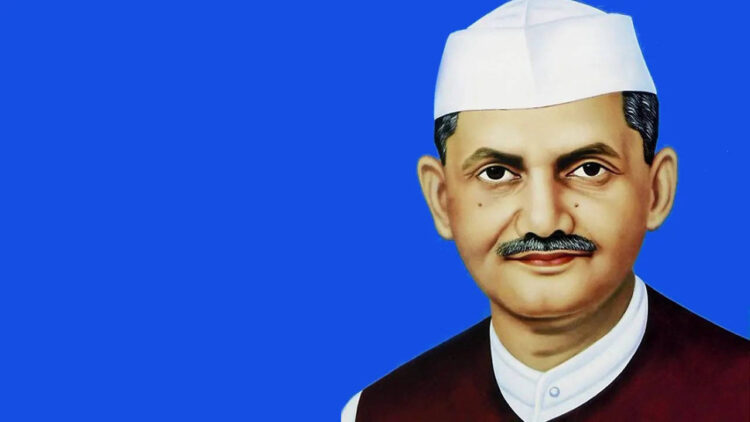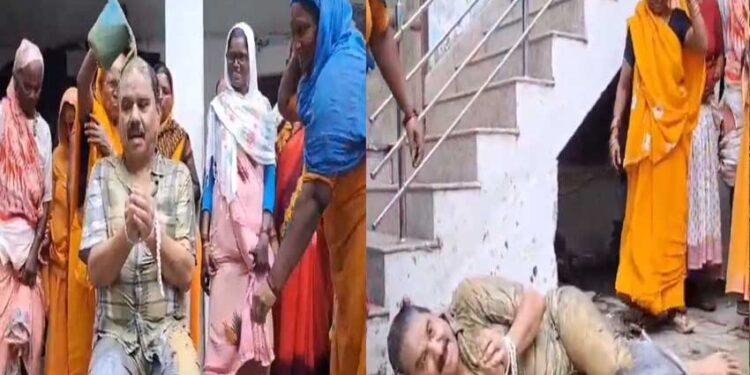History News Desk!! A famous Indian politician, great freedom fighter and the second Prime Minister of India after Jawaharlal Nehru. He was such a personality who, as the Prime Minister, not only gave the gift of military glory to the country but also showed the path of Green Revolution and industrialization. While Shastri ji considered the farmers as the food providers of the country, he also had immense love for the border guards of the country due to which he gave the slogan ‘Jai Jawan, Jai Kisan’.
life introduction
Lal Bahadur Shastri was born on October 2, 1904 in Mughalsarai, Uttar Pradesh to Munshi Sharda Prasad Srivastava. His father was a primary school teacher. Hence everyone called him ‘Munshi ji’. Later he took up the job of clerk in the Revenue Department. Lal Bahadur’s mother’s name was ‘Ramdulari’. Being the youngest in the family, the family used to fondly call the child Lal Bahadur as Nanhe. Unfortunately, when the little one turned eighteen months old, his father passed away. His mother Ramdulari went to her father Hazarilal’s house in Mirzapur.
After some time, even his maternal grandfather was no more. His maternal uncle Raghunath Prasad helped his mother a lot in raising the child without a father. He received primary education while living in his maternal home. His subsequent education took place in Harishchandra High School and Kashi Vidyapeeth. As soon as he received the degree of Shastri from Kashi Vidyapeeth, the enlightened child removed the caste-related word Srivastava, which was prevalent since birth, forever and added Shastri in front of his name. After this, the word ‘Shastri’ became synonymous with the name of ‘Lal Bahadur’.
Education
Lal Bahadur, an activist of the non-cooperation movement led by Mahatma Gandhi against the British government in India, went to jail for a short time (1921). Upon his release, he studied at Kashi Vidyapeeth (present-day Mahatma Gandhi Kashi Vidyapeeth), a nationalist university, and earned the degree of Post Graduate Shastri (scholar of scriptures). After post-graduation, he returned to politics as a follower of Gandhi, went to jail several times and held influential positions in the Congress Party of the United Provinces, now Uttar Pradesh. In 1937 and 1946, Shastri was elected to the provincial legislature.
Marriage
In 1928, he was married to ‘Lalita’, daughter of Ganesh Prasad. He had six children from Lalita ji, four sons- Harikrishna, Anil, Sunil and Ashok; And two daughters- Kusum and Suman. Of his four sons, two – Anil Shastri and Sunil Shastri are still alive, the remaining two have passed away.
meeting Nehru ji
After coming to Allahabad in 1929, he worked with Shri Tandon ji as the Secretary of Allahabad unit of ‘Bharat Sevak Sangh’. Here his closeness to Nehru ji also increased. After this, his stature continued to grow, the culmination of which was his inclusion as Home Minister in the Nehru cabinet. He remained on this post till 1951.
Slogan ‘Don’t die, don’t kill’
The slogan “Don’t die, don’t kill” was a form of “do or die”. Due to Gandhian thinking, Mahatma Gandhi had given the slogan – ‘Do or die’. This slogan was given on the same night when the Quit India Movement started. It was the effect of this slogan that the huge fire of revolution spread throughout the country. It would not be wrong if it was called a violent slogan against the British rule. This slogan was coined by Lal Bahadur Shastri in 1942, which was a very clever variation of ‘do or die’ and was very simple to understand. This slogan spread like wildfire among the people who had been suppressing anger in their hearts for hundreds of years. On one hand, Gandhian ideology was the way to get freedom from the British government by following the path of non-violence and peaceful protest, but the British probably understood this as the fear of the people. For this reason, it was clearly necessary to fight unitedly against the oppressive policies and violence of the British. Thereafter, sensing the situation, Shastri ji cleverly gave the slogan ‘Don’t die, don’t kill’, which proved to be like a revolution.
ministerial position
After the independence of India, Shastri ji was appointed as the Parliamentary Secretary of Uttar Pradesh. He became the Sentinel and Transport Minister during the tenure of Govind Ballabh Pant as Chief Minister. During his time as Transport Minister, he appointed a woman to the post of conductor for the first time. After becoming the Minister of Sentinel Department, he started using water cannon instead of batons to control the crowd. In 1951, he was appointed General Secretary of the All India Congress Committee under the leadership of Jawaharlal Nehru. In 1952, he was elected to Parliament and became the Union Minister of Railways and Transport.
second prime minister of india
His appointment to the influential post of Home Minister in 1961 earned him a reputation as a skilled mediator. After 3 years, when Jawaharlal Nehru fell ill, he was appointed a minister without any portfolio and after Nehru’s death, he became the Prime Minister of India in June 1964. Shastri was criticized for not being able to effectively deal with India’s economic problems, but he gained immense popularity for the firmness he showed when hostilities with neighboring Pakistan broke out over the disputed province of Jammu and Kashmir (1965). He died in Tashkent after signing the Tashkent Declaration agreement to go to war with Pakistan President Ayub Khan.
Slogan of ‘Jai Jawan, Jai Kisan’
Dressed in dhoti and kurta, with a cap on his head, he would roam among the farmers from village to village, waving his hands in the air, shouting Jai Jawan, Jai Kisan. This is another aspect of his personality. Even though the stature of this great man was small, his stature is very high in Indian history. After the death of Jawaharlal Nehru, Shastri ji took over as Prime Minister on June 9, 1964. His tenure was a period of political excitement and intense activity. While Pakistan and China were keeping an eye on the Indian borders, the country was also facing many economic problems. But Shastri ji solved every problem in a very simple way. Considering farmers as food providers and his immense love for the country’s border guards, he solved every problem and took the country forward with the slogan “Jai Jawan, Jai Kisan”.
demise
Shastri ji died on January 11, 1966 in Tashkent due to a heart attack after the Tashkent Agreement. However, no official report has been released till date regarding his death. His family members have been raising the question of his death from time to time. It is a matter of shame for the country that the reason for the death of such a capable leader has not been clarified till date.
Honors and Awards
The whole of India remembers Shastriji with reverence for his simplicity, patriotism and honesty. He was awarded Bharat Ratna in the year 1966.









